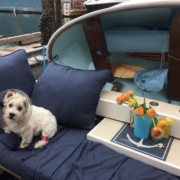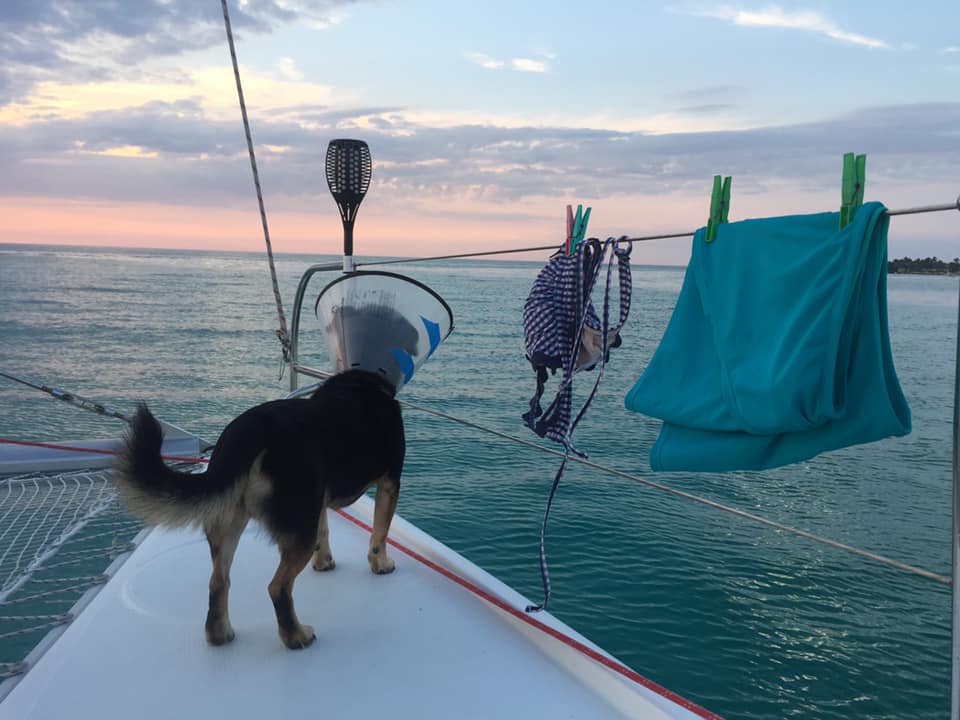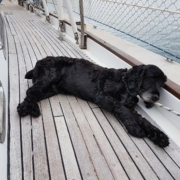What Is Heat Stroke?
Heat stroke also know as heat stress occurs when the generation of heat exceeds the body’s ability to lose heat. Generally speaking, heat stress is a condition experienced more in the warmer months of the year although it is not unheard of in the milder seasons. It all depends on the environment your dog is exposed to.
Typically, we relate heat stroke to dogs left in a hot car in summer time or kept outdoors without any shade. As dog lovers we are quick to jump to the rescue of the dog (while berating the owner under our breath). Both situations are well-known environments exposing dogs to heat stroke and just as lethal is leaving your dog on a hot boat.
All boats are different, some more open than others so it is up to the owner to evaluate the amount of ventilation your boat offers. Down below, the temperature of boats can become quite intense, especially when the wind is not blowing in the right direction to the open hatches or it is dead calm – boats have the potential to become a mini sauna.
Unlike humans who have a complex cooling system through our skin, dogs sweat glands are only located in their feet and around their noses, so they rely heavily on panting and external cooling to expel heat. Even this evaporative cooling method relies on good air flow to be able to cool down your dog adequately.
Prevention is better than cure with heatstroke especially when on a boat and a vet is not accessible.
Tips To Help Keep Your Dog Safe From Heat Exposure On A Boat

Bear enjoying his sprinkler mat in the hot Australian summer.
- Keep your boat cool and well-ventilated. Do not close the boat while your dog is inside.
- Ensure your dogs have access to clean, fresh drinking water. Placing two-three water bowls in separate locations on the boat in case one of the bowls is knocked over always ensures your dog has plenty of water.
- If your dog likes to hang out on deck, ensure that he has access to a shady area and encourage him to use that area. Place water in this space as well.
- Exercise your dog during the cooler parts of the day.
- Avoid hot sand, hot pavements, and hot roads. I’m always surprised during the height of summer here in Australia, how many people walk their dogs on scorching hot surfaces. Never assume that the ground is fine for your dog’s paws. Bend down and feel the surface yourself with your hand. If it is too hot for you, it is too hot for your dog. Burnt, blistered paws are excruciatingly painful for your dog.
- Keep coats clipped. Most pet clippers can be used off a marine 12-volt battery. Thinning combs are also helpful if you cannot manage a clipper. I’ve no doubt there are breeders out there who will disagree with me, arguing that a dog can regulate the temperature despite their coat. I’m speaking from experience. Witnessing my spaniels Maxy and Mel panting and lethargic with a longer coat compared to their change in energy and vitality following a haircut, they were without a doubt more comfortable following a clip.
- Be aware that life jackets are made of synthetic fabics that don’t allow the body to breathe naturally. They are an important safety measure for all dogs onboard however, keep your dog cool when they are wearing the life jacket out of the water.
There are certain breeds such as pugs and bulldogs that are susceptible to heatstroke. Talk to your vet about how to best care for these gorgeous breeds when it comes to heat stroke.
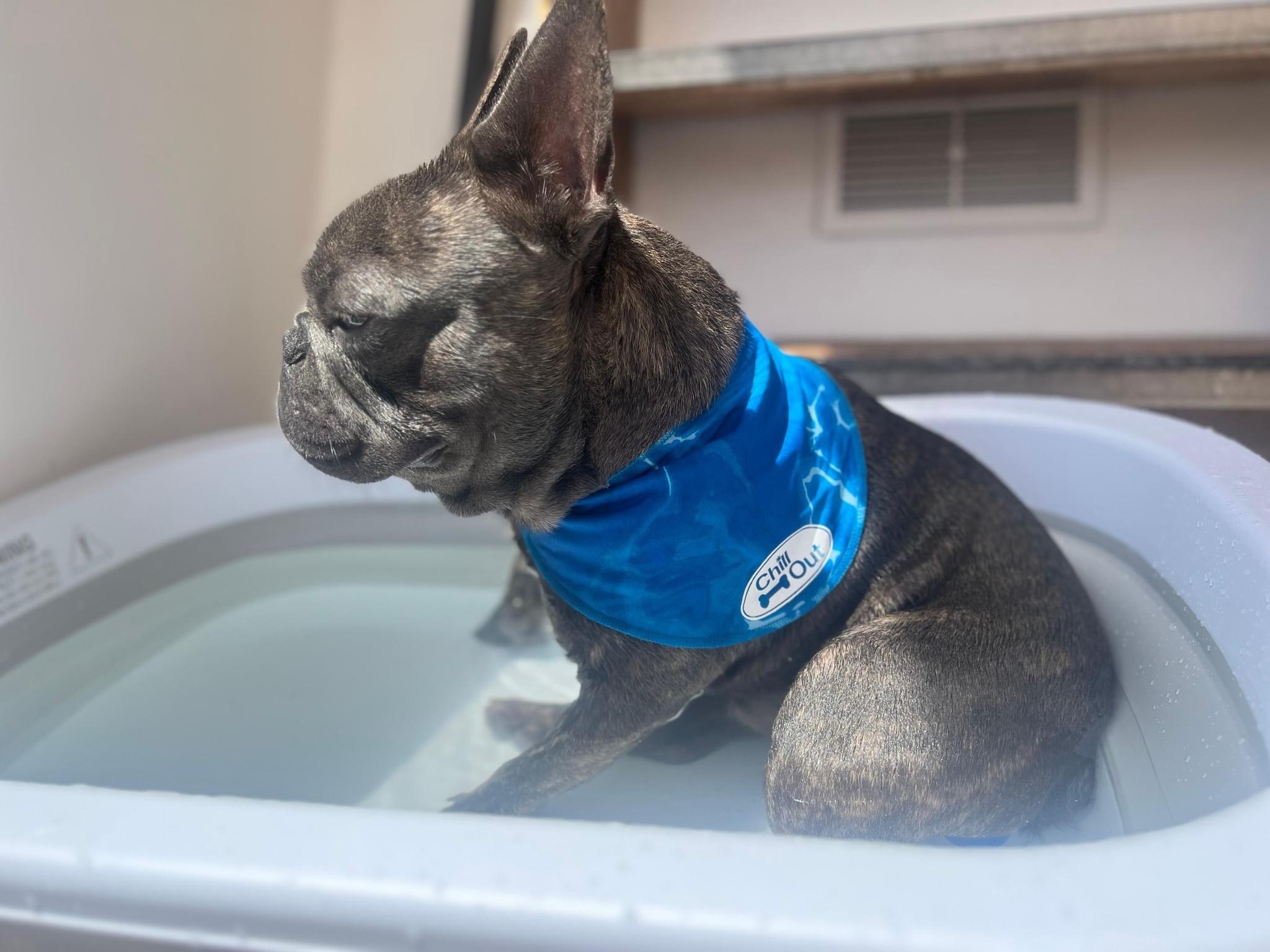
Otto cools down in a baby bath in his Chill Out neck bandana.
Sometimes we take every precaution in life and still meet misfortune. Just in case something completely unforeseen goes wrong, let’s have a look at the signs of heat stress and what you can do to help your dog to cool down.
SYMPTOMS
According to Royal Society for the Prevention of Cruelty to Animals these are the main symptoms to look out for with a dog you suspect may have heatstroke.
- Panting increases as heatstroke progresses internally.
- Excessive drooling.
- Your dog is unable to feel settled.
- Red gums and a bright red tongue.
- Distressed breathing.
- The dog may appear confused. You know your dog’s personality and behaviour best, so you will know when they are doing things out of character.
- They just want to lie down which is unusual for them.
- Muscle tremors.
- The dog collapses.
- They are not going for a wee or have little to give when they do go.
- Coma
This is a comprehensive list but one worth familiarising yourself with because your dog may not present with all these symptoms. Keep a close eye and don’t ignore symptoms – investigate them.
If you find your furry four-legged crew member is suffering heat stroke, then you will need to help them. Following is an emergency first aid list for your consideration:
EMERGENCY FIRST AID FOR HEAT STROKE

Belle & Lily on deck with full shade in their travel crate. Add a cooling mat for extra chill.
Aim: To normalise the body temperature of your dog.
- Remove your dog from the hot environment.
- Use wet towels or washcloths saturated with lukewarm or cool water and place on your dog’s body ensuring that the water is penetrating the fur to the skin.
IMPORTANT NOTE: Do not use ice or ice-cold water as this may create more problems for your dog. Extreme cold can cause blood vessels to compress or tighten which will prevent the dog’s body core from cooling which causes the internal temperature of the dog to continue to rise.
If necessary, wet down the area surrounding your dog.
Offer your dog water but do not force feed.
If you can monitor their temperature, you are aiming to get it down to 39.5 degrees Celsius (103.1 degrees Fahrenheit). Once you reach these temperatures, stop cooling the dog so you do not take him the other way into hypothermia – being too cold.
If you can’t lower your dogs temperature, you really must seek veterinary assistance.
I understand that with our cruising lifestyles we are not always able to access veterinary care. Where you can, at the very least try and connect with a vet via phone and, if possible, divert your sail course to get your dog to a vet as soon as possible for a check-up. You can always return to your sailing destination.
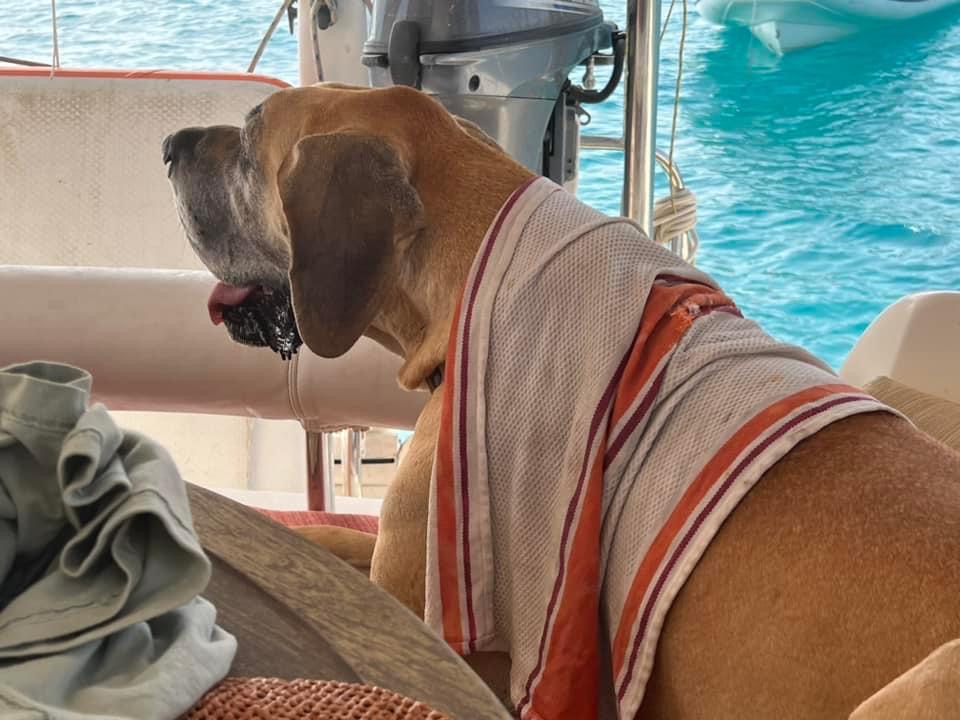
Lili enjoying a cool wet towel draped over her Great Dane body.
Impawtent Message
Living in a marina in Queensland, Australia can get ridiculously hot. We have installed an airconditioner for marina living but I hesitate to leave it on when we are away from the boat for long periods. Marina electricity can be turned off unexpectedly and because the boat is closed up to keep the cool air in, Harry could roast inside once the cool air disapates.
When the aircon isn’t on, our hatches are wide open but some days there is barely a breath of breeze to tickle a bird’s feather. To help keep the boat cool while we are marina-bound we have installed a full-length shade cloth cover that goes from the bow to the stern of the boat. Without a doubt, this shade shaves about two to three degrees off the internal temperature of the boat. Harry has access to fans and cooling mats and areas of the boat that have been kept dark and cool.
Impawtent Questions
- Do you have a doggy thermometer on board, and do you know how to use it?
- Do you have your vet or a list of vets you can contact, aligned with your sailing itinerary?
- What measures can you take on your own boat to ensure your dog never has to experience heat stress?
Pop any suggestions in the comments below on how you keep your dog cool onboard. Here are some suggestions from our Dogs Who Sail members.
Dogs Who Sail are not affiliated with any brands. The links below are examples only. Please research your preferred pet supplier for similiar products. There are so many different brands and styles to choose from!
Cooling Bandana https://www.petbarn.com.au/all-for-paws-chill-out-dog-bandana-blue?sku=131902
Cooling Mat https://www.petbarn.com.au/all-for-paws-chill-out-dog-cool-mat?sku=127050
Dog Cooling Vest https://www.petcircle.com.au/product/zippypaws-dog-cooling-vest-blue/zp62zpc1513
Dog Sprinkler https://www.petstock.com.au/products/lexi-me-pet-sprinkler-pad
Dog Paddle Pool https://petpawz.com.au/products/dog-swimming-pool
Or be like Benji (below) and grab a plastic basin from your local hardware shop.
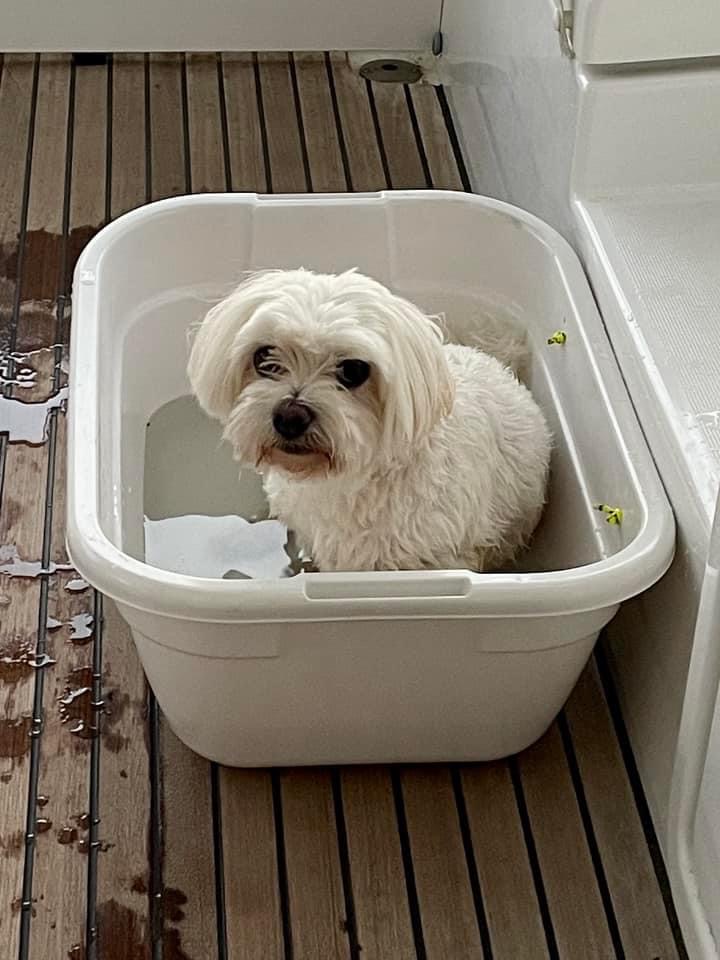
Benji is no frills or spills, happily cooling off in a bucket of cool water.
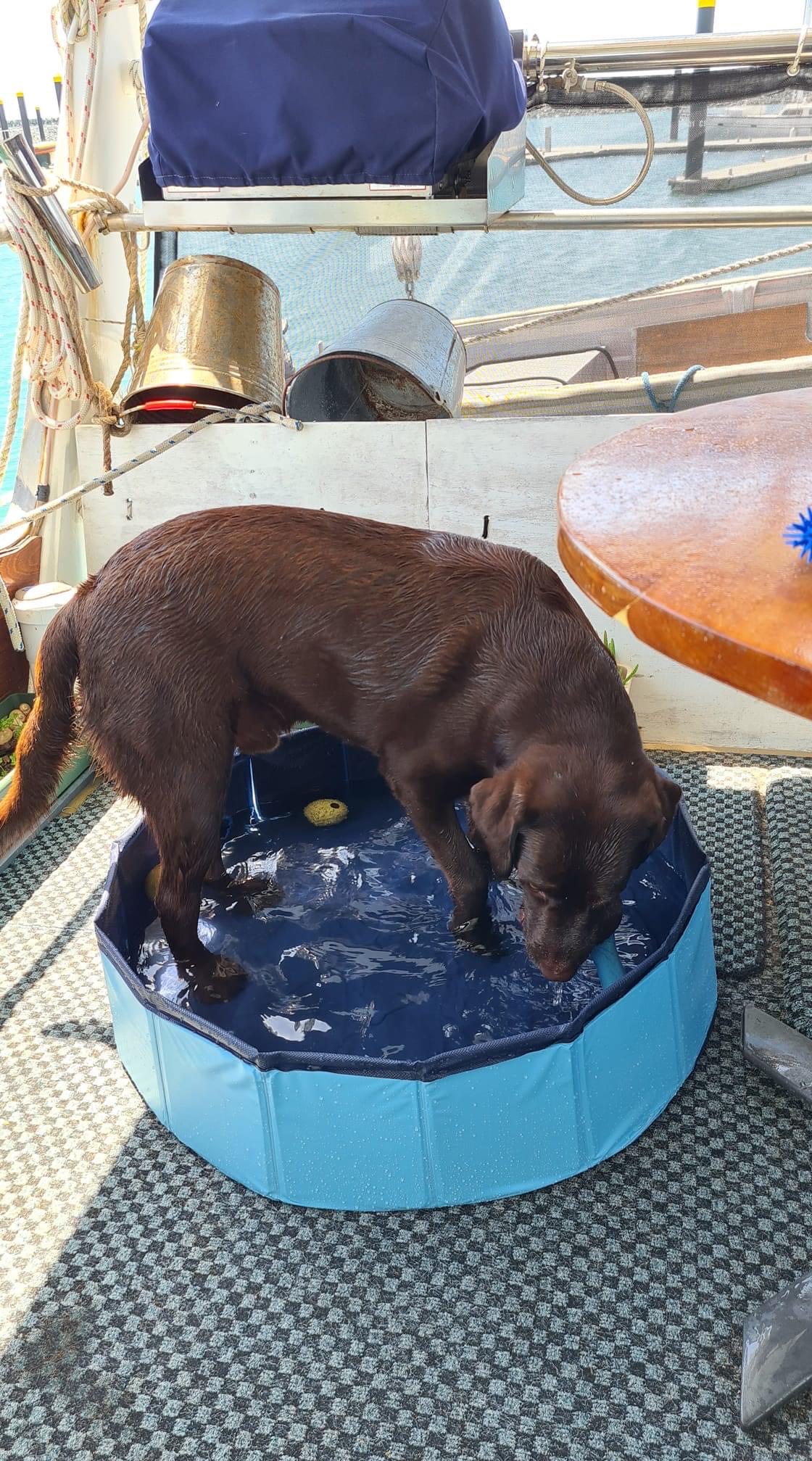
Bear has it all! A dog paddle pool to match his sprinkler mat seen earlier in the post.

Doggy Dyer has all bases covered. Just go for a refreshing swim!

Ewok Eric wrapped in his wet Dock & Bay quick dry towel.
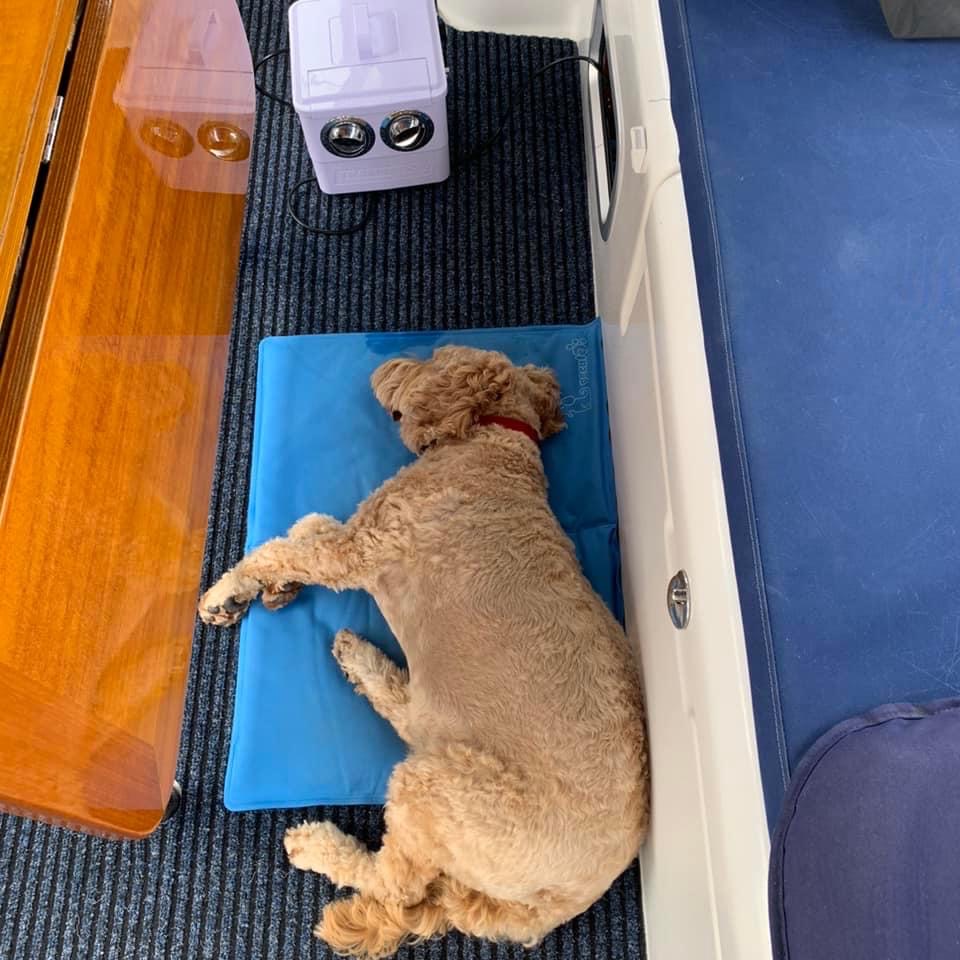
Schooner chilling on his cooling mat with Trans Cool fan. As you do in Sicily of course.

Scout smiling in his cooling vest.

Gorgeous little Weezy cooling off in front of the fan after a swim.
Thank you to Dogs Who Sail members for your phots and ideas. xx



